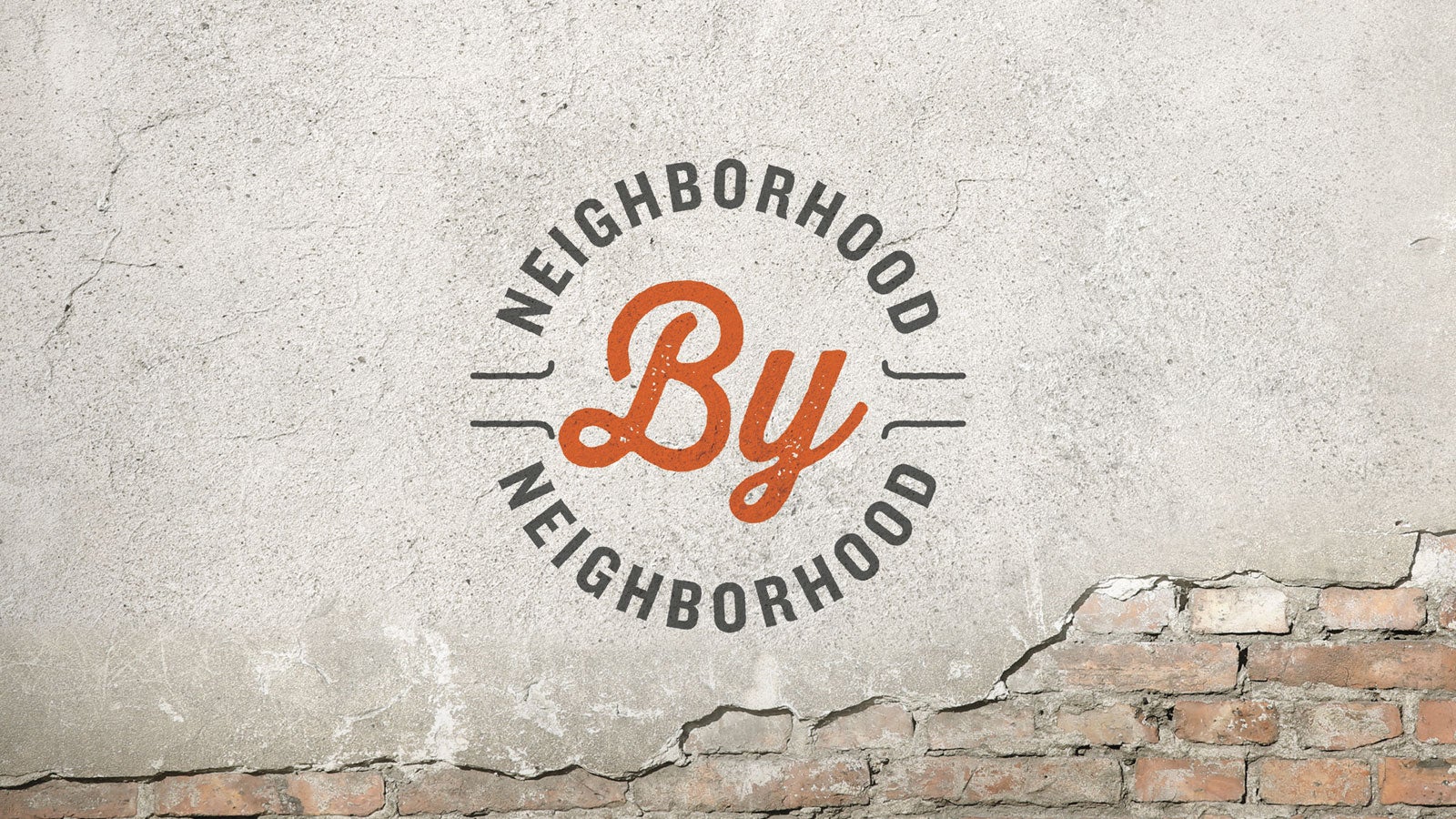
Neighborhood by Neighborhood
Fall 2016 | By Jeffrey C. Billman ’01
This past spring, a group of about 100 Jones High School students were summoned to an assembly in the school auditorium.
“What did we do?” thought Jenny Simon, who graduated from Jones earlier this year.
As it turned out, they weren’t in trouble. In fact, they were about to receive news that, for many of them, would be life-changing.

The students were all residents of Parramore, a predominantly African American neighborhood just west of downtown Orlando, across Interstate 4 and the aptly named Division Avenue, markers of segregation that separated white from black.
According to James Clark, a UCF history lecturer, this history is intrinsic to understanding why the neighborhood has long been synonymous with blight and crime. Start with the fact that Parramore was named after a Confederate Army captain. Add to it that in the first half of the 20th century, blacks were forced to give up their homes in east Orlando and move into public housing in Parramore, where they suffered generations of institutional neglect.
That’s not to say the city hasn’t tried. The millions spent on initiatives to lure commerce, improve housing, reduce crime and develop the Creative Village tech hub — which will be anchored by UCF’s new downtown campus — attest to officials’ efforts.
Some of it was successful. “When I first was there, [there was] more of the drug dealing, police being around our neighborhood,” says Simon, 18. “Over time, a lot of that has changed.”
But problems persist: unemployment near 25 percent, incomes nearly a third of Orlando’s average, lackluster graduation rates, violent crime. According to a survey reported by the Orlando Sentinel last year, nearly one-third of the neighborhood’s children lost a parent to incarceration or death in the previous 12 months.
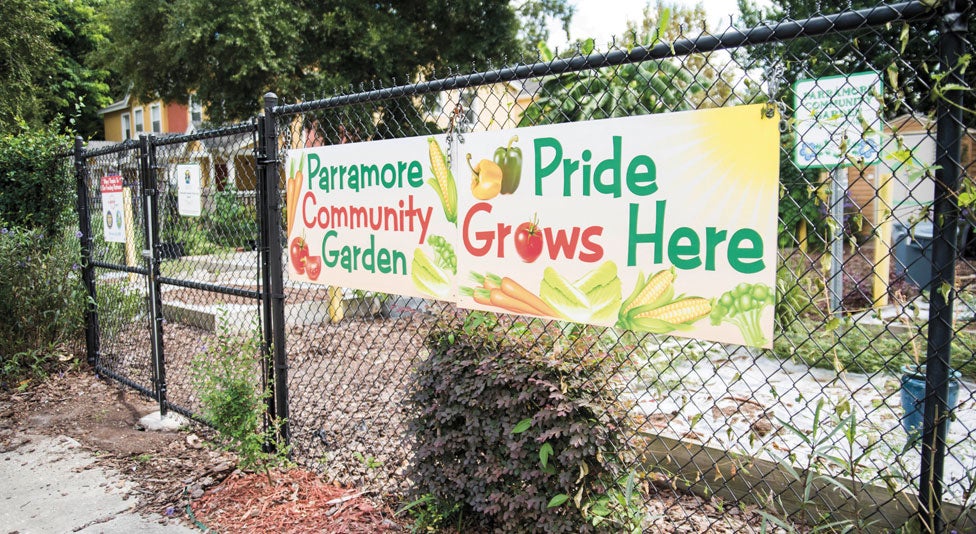
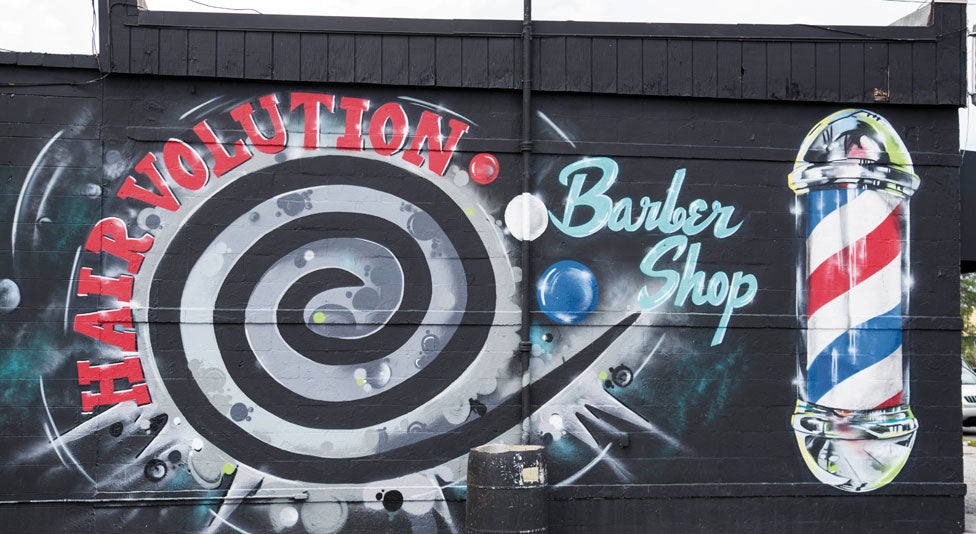
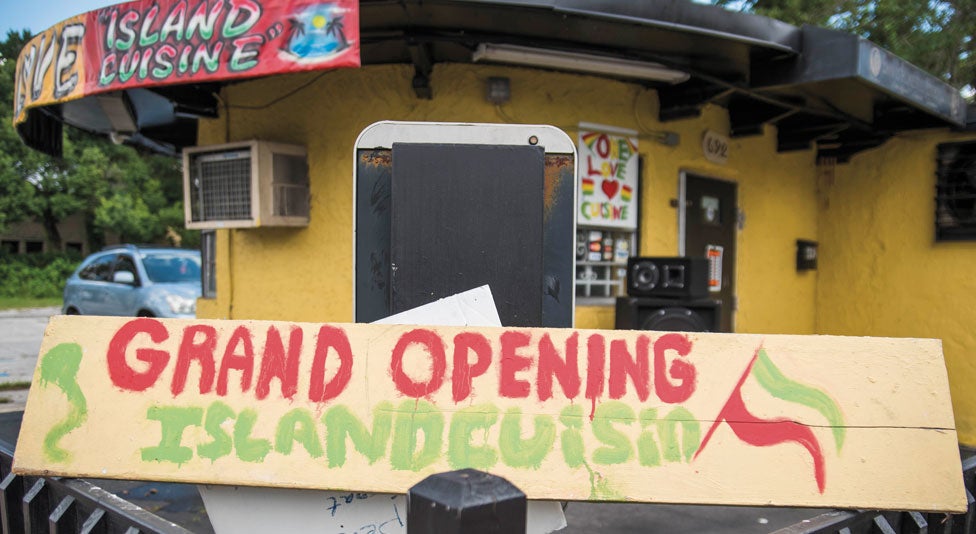
This is the world in which those Jones High students grew up, the world in which they and their parents tried to imagine a brighter future. Simon, then a senior, had tried to get a softball scholarship, but that didn’t pan out. “I was in the auditorium,” she says, “stressing about how we were going to pay for college.”
By the time the students left the auditorium, she didn’t have to worry about that anymore. None of the Parramore students did. Their college, they were told, would be entirely paid for — tuition, housing, books, everything — as long as they graduated and were accepted to a state university, community college or vocational school in Florida.
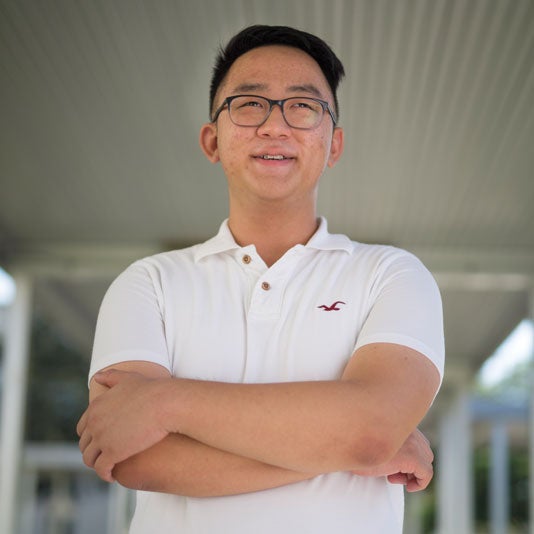
Current Jones High School senior Chris Chong plans to attend UCF next fall.
“I didn’t really believe it at first,” says Chris Chong, who plans to attend UCF next fall. “I felt like there was a catch somewhere.”
But there wasn’t. In another Orlando neighborhood, something similar had been happening for the past 23 years. Now, Tangelo Park barely resembles its former self: Property values are up, crime is down and families are moving into the community rather than fleeing it. More than 90 percent of Tangelo Park students earn a high school diploma, and almost 150 have used a scholarship to earn a college degree.
“We’ve broken the cycle,” says Chuck Dziuban, director of the Research Initiative for Teaching Effectiveness at UCF and the school’s liaison with the Tangelo Park program. “What you see is this remarkable change in the community
And now the man behind that program hopes to replicate its success on a larger scale, this time in Parramore, where he expects to spend $3 million a year. In May, he awarded the first 15 scholarships.
Jones High School students who live in the Parramore district will have their college expenses entirely paid for — tuition, housing, books, everything — as long as they graduate and are accepted to a state university, community college or vocational school in Florida.
Harris Rosen is 77, white-haired and still vigorous. For more than a quarter of his life, he has been a generous philanthropist — supporting not just the Tangelo Park and Parramore programs, but also donating $18 million to UCF in 2000 to help fund what is now the Rosen College of Hospitality Management.
But he didn’t start out that way. Forty-two years ago, he started with a two-story Quality Inn that he has since expanded into a hotel empire along Orlando’s International Drive. Nearby is Tangelo Park, a small neighborhood of about 3,000 named for the orange groves that once grew there.
A quarter century ago, like so many other disadvantaged neighborhoods, Tangelo Park wasn’t somewhere you went if you didn’t have to.
“Let’s just say it was a community that needed some help,” Rosen says. “It was not safe; teachers were told that they [had to] leave right after classes.”
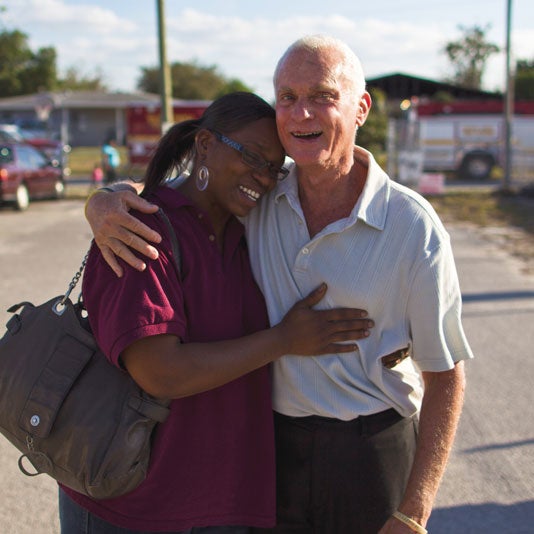
Harris Rosen is hugged by a Tangelo Park resident.
“I could virtually sit in my office and see drug deals going down across the street,” recalls Bob Allen, then the principal of Tangelo Park Elementary. His school — a D school, bordering on an F, he says — was broken into about once a week. The neighborhood’s homes, many owned by out-of-state landlords, were in various states of disrepair. Families — almost all black, almost all poor, many single-parent households — came and went; more than 90 percent of elementary school students moved away from Tangelo Park.
“The thing is, if you can’t keep [children] in the schools, you can’t educate them,” Allen says. Indeed, fewer than three in five Tangelo Park kids were graduating from high school.
Tangelo Park’s not like that now. The mobility rate is near zero. GPAs hover around 3.0. Crime is down more than 50 percent. In 2014, every single Tangelo high school student received a diploma.
It’s easy to mistake correlation for causation — after all, crime rates have fallen and graduation rates have risen in underserved communities all over the country. It’s also easy to reduce Tangelo Park’s success to that of a wealthy white man parachuting in to save a struggling black neighborhood. But prior to Rosen’s arrival, residents were already rallying to improve the neighborhood.
Even so: “Mr. Rosen, he had infused that hope we were looking for,” Allen says.
One afternoon in 1993, Rosen had an epiphany. “I heard a voice say, ‘It’s time for you to thank God for everything that has happened to you,’ ” he says. “I asked myself … what to do. ”
Then it came to him: education.
His parents’ families had immigrated from Eastern Europe, and he’d grown up poor in New York City’s Lower East Side; nobody in his family had gone to college. “My mom and dad would sit down with my brother and me and say, ‘Education will level the playing field,’ ” he says.
He called school board member Bill Spoone, Dr. Phillips High School’s first principal, and early education expert Sarah Sprinkel and told them he wanted to send more kids to college.
“If you want to prepare youngsters for college,” Sprinkel told him, “you need to start them early.” The sooner they start preschool, Sprinkel said, the better they’ll do in kindergarten, then elementary school, then middle school, then high school. “It’s an advantage they’ll never lose.”
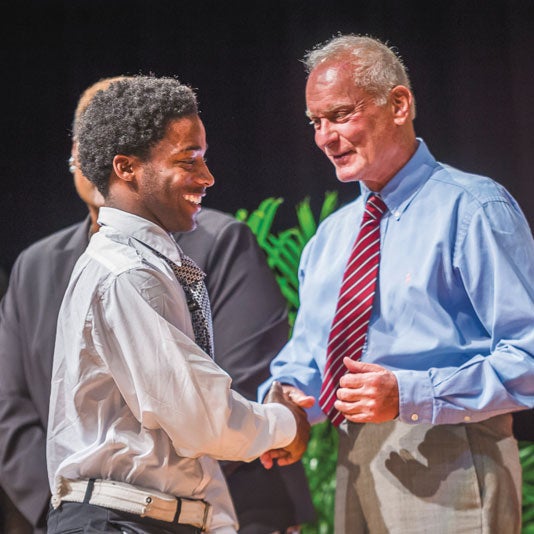
Rosen shakes hands with a recent graduate during Jones High School’s commencement this past spring.
So the program they created offered both college scholarships and a preschool program for children age 2 and up. It was a simple setup, but it was also revolutionary in its scope: Instead of a broad-based investment over a few years, Rosen’s investment would be narrowly focused over a few decades.
“You have to think [about] one community vertically,” Dziuban explains. “This is the philanthropy of you just don’t write a check and walk away.”
The question was, which community? Orange County Commissioner Mable Butler suggested Tangelo Park. “This community needs help,” she told Rosen. “And they are actively involved in trying to change things … so they are ready for new ideas.”
Rosen was sold on Tangelo, but Tangelo wasn’t immediately sold on Rosen. “Typically, in our community, [investors] want to come in and sell you a bill of goods, and then look for something in return,” says Allen. “The community, of course, was a little skeptical.”
After Rosen announced that he would immediately award scholarships, the Tangelo residents came around quickly. Twenty-four Dr. Phillips graduates received a scholarship that first year.
The program did something else unorthodox: Instead of building a new preschool, Rosen decided to put several small preschools — six students for every teacher — inside people’s homes. He paid for the renovations and equipment and made sure the providers were certified and insured.
It didn’t take long to see improvements. “The mobility rate went from 95 percent to about 42 percent in a couple of years,” Allen says. “The following year, we became an A school.”
The mobility rate went down primarily for two reasons: One, young mothers were able to work or go back to school, which increased their financial stability; and two, people now had an incentive to stay in Tangelo Park — and, perhaps, to move there.
Kamillia Crawford ’16 was born in Tangelo and was the first of her family to use the scholarship. Earlier this year, she was one of 20 undergraduate students awarded the Order of Pegasus, UCF’s highest student academic honor. She recently flew to California to begin a stint in the Air Force and plans on attending law school.
For Crawford, the scholarship was a safety net. After her first year at UCF, she didn’t even need it. She had Pell Grants and Bright Futures, Air Force ROTC and multiple academic scholarships; and as a resident assistant, she received free housing and a stipend.
“Neither of my parents graduated from college. … It opened up a lot of opportunity for me that wouldn’t have happened without a scholarship.”
This, Dziuban says, isn’t unusual. The program encourages students to seek out other scholarships and sources of financial aid. “If nothing else works for [Rosen scholars], they have a scholarship,” he says. “But they’re getting other [assistance]. So basically Harris is spending less and less money on the scholarship program.”
In other words, the program helps Tangelo students help themselves. “I probably wouldn’t have gone to UCF right away without scholarships,” says Kira Leach, a current UCF student majoring in psychology and a 2014 valedictorian at Dr. Phillips. “Neither of my parents graduated from college. … It opened up a lot of opportunity for me that wouldn’t have happened without a scholarship.”
For the first 10 years of the Tangelo program, Rosen didn’t talk much about it, nor did he bother collecting data on the program’s results.
“I believed that it would be misinterpreted,” he says. “That if … people started hearing about us, they would think ‘Rosen is doing it because he wanted a pat on the back.’ ”
Then someone pointed out something rather profound: By not talking about what he was doing in Tangelo, Rosen was keeping secret something that had proven results.
“My hope now is that when … we talk to The New York Times or we’re on a TV show, that lurking in the shadows is someone who will say, ‘That sounds like a great program. Let’s give Harris a call and see if we can get things moving in Philadelphia,’ ” he says.
“If you want to help an underserved community, you focus laserlike on the underserved community and ask yourself, ‘What can we do to help?’”
He decided to approach the private sector, but to do that, he needed numbers. Even the most altruistic philanthropists want to quantify what their investment will do. Dziuban commissioned a study, and the results were remarkable: For every dollar Rosen spent in Tangelo, the community received $7 in benefits.
He had the data. He had the template.
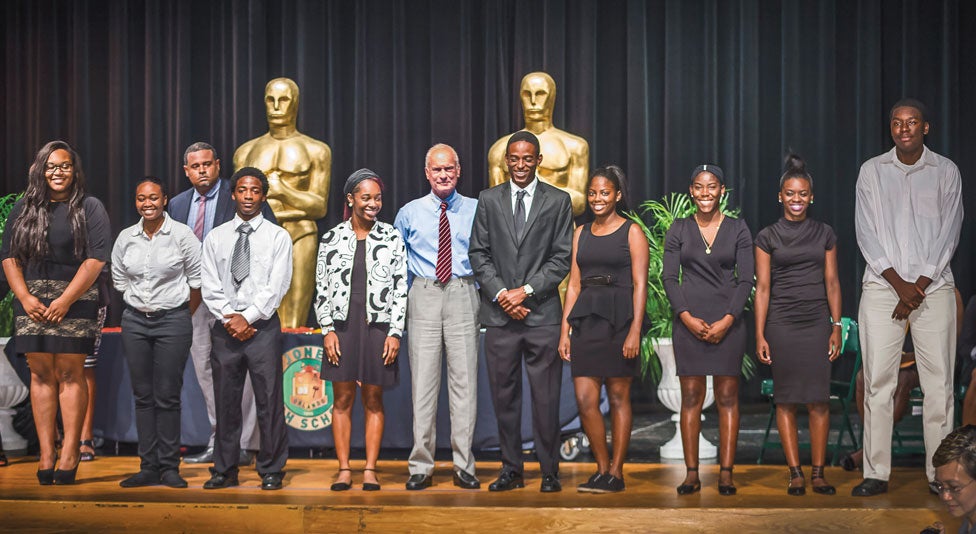
Rosen (center) at Jones High School’s graduation with students who were awarded full scholarships as part of his program.
“If you want to help an underserved community, you focus laserlike on the underserved community,” Rosen says, “and ask yourself, ‘What can we do to help?’ It’s not rocket science. … You say, if we have income inequality in America, and we certainly do … how do you correct that? Education will level the playing field. Listen: A kid grows up in Flatbush and goes to Harvard, and another kid grows up in Winter Park and he goes to Harvard. Who cares where they came from if they both graduate, right? … And not only that, when they graduate, they’re no longer underserved or disadvantaged, they’re advantaged, because they’re sitting around a table with their colleagues, and, of course, the question arises, how much money do you owe? And so our kids are sitting there quietly, smiling and saying, ‘We don’t owe a penny.’ So from underserved to advantaged in four years.”
That’s certainly the case for Brikti Tsegaye.
“I know that a lot of people … I’ve met in college that didn’t grow up in Tangelo Park, they took out every sort of loan available,” says Tsegaye, a pre-nursing major at UCF and a Tangelo Park scholarship recipient. “Loans aren’t something I have to worry about paying.”
But Rosen’s most poignant pitch is personal, a letter from a fifth- or sixth-grader he received earlier this year, thanking him for the breakfast buffet he provided Tangelo students immediately before the FCAT.
“Mr. Rosen,” the letter begins, “I just want to tell you how much I loved the breakfast. It made me so strong. I know that I killed the FCAT. But most importantly, I love the strawberries. And Mr. Rosen, you are like a strawberry. So sweet.”
“And what is that worth?” Rosen asks, his eyes alit. “What is that worth? Getting a letter from a young lady who says I’m like a strawberry.”
Jeffrey C. Billman ’01 ’10MA graduated from UCF with a B.A. in journalism and an M.A. in political science. He is currently the editor in chief of INDY Week in Raleigh-Durham, North Carolina.